Abstract
Holographic photopolymers are subject to extensive studies in recent years because they are low-cost, easy-to-handle, self-processing materials, which have a number of advantages over more traditional holographic materials. The development of low-toxicity photopolymers that are environmentally friendly is highly desirable. The availability of low-toxicity photopolymers will permit the mass production of commercial holograms without harm to the environment. This paper reviews recent developments in low-toxicity water-soluble holographic photopolymers. A novel composition for a water-soluble, low-toxicity photopolymer is described. This new holographic photopolymer has 90% diffraction efficiency in the transmission mode of recording and 50% diffraction efficiency in the reflection mode of recording. This photopolymer has all the necessary holographic characteristics to make it very attractive for commercialisation. The optimised chemical composition of the holographic photopolymer for the production of pressure sensors is addressed. A novel and unique feature of this new material is its high sensitivity to pressure, which can be controlled by changing its composition. Several promising environmentally friendly optical materials are being developed for future holographic applications. The presented review of low-toxicity, water-soluble, holographic photopolymers is the first of its kind. Thus, the importance of the review is twofold—it helps contribute to the development of low-toxicity holographic photopolymers, and it provides insight and new ideas for the development of water-soluble photopolymers for other applications.
1. Introduction
Dry photo-polymeric materials are attractive as holographic recording media. These materials are self-processing and of low cost. There is a growing need for the production of environmentally friendly holographic recording materials. This is the main reason for the increasing efforts towards the development of non-toxic photopolymers in recent years.
The objective of this work is to present for the first time a review of water-soluble, low-toxicity, holographic photopolymers.
Holographic photopolymers were first described in the late 1960s. At that time, they were not good candidates for the mass production of optical elements since they were not able to record high spatial frequency gratings. More traditional materials such as dichromated gelatin and silver halide photographic emulsion performed much better. In the early 1980s, a technique for the mass production of surface relief holograms was developed. This embossing technique opened the possibility for great commercial success for surface holograms.
In 1987, Calixto [1] reported the development of an acrylamide-based (AA-based) material, whose chemical composition included acrylamide (AA) monomer, triethanolamine (TEA), methylene blue, and Polyvinyl Alcohol (PVA) as a binder. Fimia et al. [2,3] developed a method for increasing the sensitivity of acrylamide photopolymers by reducing the inhibition time caused by oxygen and reported a diffraction efficiency (DE) of 40% at a spatial frequency of 1000 lines/mm, obtained with an exposure of 3 mJ/cm2 [2,3]. The photopolymer composition described by Calixto [1] was optimised by Martin et al. [4] for recording in the 514 nm, using a xanthene dye as a photosensitiser and a crosslinking monomer bisacrylamide. Diffraction efficiencies above 80% were obtained when the exposure energy was 80 mJ/cm2. Blaya et al. [5] developed further the acrylamide photopolymer for recording at 633 nm. A different crosslinking monomer was used: N,N′-dihydroxiethylenbisacrylamide, the and sensitivity of the photopolymer increased [5]. In 1998, Blaya et al. reported results from the investigation of the effects of the addition of a cross-linking monomer to a photopolymerisable material [6]. The diffraction gratings, recorded in the optimised material, had a diffraction efficiency of around 88%, achieved with an energy exposure of 12 mJ/cm2 [6]. Regardless of the successful development of the acrylamide-based holographic photopolymers, their toxicity remains a great disadvantage for the mass production of holographic optical elements and their use at an industrial scale.
The efforts of researchers to develop environmentally friendly materials and technologies for a sustainable future have increased recently [7,8]. The new developments in holographic materials are of particular interest for holographic applications [9,10,11]. The development of holographic photopolymers with low toxicity is of particular interest in order to reduce the environmental impact of mass production. We present an overview of the low-toxicity, water-soluble, holographic photopolymer materials, which have been developed until now. Three important types of “green”, holographic, water-soluble photopolymers are described, namely Biophotopol, N-isopropylacrylamide-based photopolymer, and Diacetone Acrylamide-based holographic photopolymer. We examine the main developments of each work and present some attractive applications of the novel photopolymers.
2. Water-Soluble Photopolymer Materials
Holographic photopolymer materials are in the form of a thin film, which is light-sensitive and able to record holograms when exposed to laser illumination. The holograms recorded in photopolymers offer great advantages in comparison to current security holograms, which is largely due to their thickness and greater versatility, such as the capability of recording multiple holograms within the same volume.
Most water-soluble holographic photopolymerisable materials contain monomers, for example, acrylamides, an electron donor, which may be Triethanolamine (TEA), a light absorbing dye, which can be Methylene Blue or Erythrosine B, and a polymer binder such as Polyvinyl Alcohol [12].
A high-quality volume holographic material needs to have all of the characteristics listed below:
- Very good optical quality
- Low scattering
- Sufficient thickness to have the required storage density for holographic storage applications
- Photosensitivity to the wavelength of the laser used for recording
- No need for heat treatment or chemical processing
- Long-term thermal stability and humidity within a certain range to achieve sufficient storage life
AA-based photopolymers have been under development and optimisation for many years [13,14,15] and have found many different optical applications [16,17,18]. A typical chemical composition of an AA-based photopolymer sensitive to green light is the following (Figure 1): 0.6 g monomer (AA), 2 mL TEA, 0.2 g cross-linking monomer N,N′-methylenebisacrylamide (BA), 4 mL erythrosin B (EB) dye (0.11% wt. water stock solution), and 9 mL stock solution of PVA in water (20% wt.) [19].
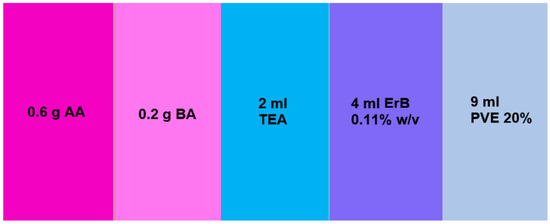
Figure 1.
Typical chemical composition of AA-based photopolymer.
Figure 2 presents a schematic of the photopolymerisation process in the photopolymer layer during hologram recording. A diffraction grating is recorded (Figure 2c) when the photopolymer layer is illuminated by two beams of laser light (Figure 2b).
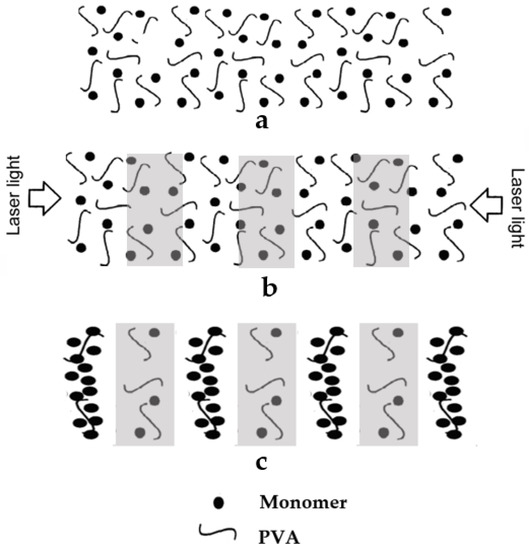
Figure 2.
Schematic of the photopolymerisation process in a photopolymer layer during hologram recording: (a) photopolymer layer before exposure to laser light; (b) exposure to light; (c) photopolymer layer after light exposure.
The main disadvantage of an AA-based photopolymer is the AA monomer, a substance, which is well-known to be carcinogenic [20,21,22]. Photopolymers with PVA or gelatine binder and acrylamide monomers are hydrophilic [9,10,11,12,13,14,15]. All of these photopolymers contain toxic acrylamide, and they have low environmental compatibility [23].
3. Low-Toxicity Water-Soluble Photopolymers
3.1. Biophotopol Photopolymer
Ortuño et al. [23,24] reported the development of a new holographic photopolymer, biophotopol, which has lower toxicity than that of the known acrylamide-based photopolymers. Acrylamide was replaced by NaAO, and the dye was replaced by the salt 5′-riboflavin monophosphate (PRF). Sodium acrylate is less toxic than that AA. The main holographic parameters of Biophotopol have been studied. High diffraction efficiencies of 77% were measured in photopolymer layers 900 μm thick when the energetic exposure was 197 mJ/cm2. The authors pointed out that Biophotopol has the potential for recording many holograms in the same polymer layer. Thus, the new polymer has a “green” nature [23,24].
In 2016, Navarro-Fuster et al. [25] reported a method, which led to the improvement of the energetic sensitivity of the new “green” photopolymer (Biophotopol). The material’s energetic sensitivity was improved in 300 µm thick layers by tuning the recording wavelength to 488 nm. The results show that the energetic sensitivity of the Biophotopol material remains constant for recording at 488 nm, and the thicknesses are greater than 300 µm [25].
In 2017, Navarro-Fuster et al. [26] demonstrated the holographic data storage capacity of Biophotopol. The authors report that the performance of Biophotopol is very similar to that of the AA-based photopolymer in data storage applications.
3.2. NIPA-Based Photopolymer
Recently, Mikulchyk et al. [27] developed a photopolymer, which can record transmission and reflection holograms. The approach applied was to replace the toxic AA with low-toxicity N-isopropylacrylamide. The authors report optimised recording conditions at different spatial frequencies (300, 1000, and 2700 lines/mm) in transmission mode and 2700 lines/mm when the recording is performed in reflection mode. The authors also reported the reversibility of the temperature-induced changes of the diffraction efficiency of transmission gratings within 2% [27]. These results indicate a possibility for the development of different types of holographic temperature sensors [27].
More recently, Cody et al. [28] reported a study of the temperature response of transmission holograms. It has been experimentally shown that holograms recorded in NIPA-based polymer layers exhibit memory of their exposure to temperatures higher than 45 °C [28].
3.3. Diacetone Acrylamide-Based Photopolymer
The main monomer in DA-based photopolymer is Diacetone Acrylamide (DA) [29]. DA contains a minimal amount of 0.1 wt % AA. DA is not a carcinogen according to research reported by the IARC [30]. DA is known as a material of category 4 concerning its acute toxicity, while AA is a category 3 high-risk substance [31]. DA has high hydrophilicity, and via a radical chain mechanism, it polymerises with different co-monomers [32]. High diffraction efficiencies >90% in a layer with a thickness of 70 µm were reported by the authors [29]. DA-based photopolymer is a “green” alternative to the well-developed AA-based photopolymers [4,33,34,35,36] for different holographic applications.
Cody et al. [19] investigated the shrinkage induced via the polymerisation of the DA-based photopolymer. The authors reported a shrinkage reduction of 10%–15% in the DA-based photopolymer relative to the AA-based photopolymer [19]. The authors concluded that this reduction in shrinkage is probably due to the replacement of the AA monomer with the larger DA monomer [19].
3.4. Bright Holograms in DA-Based Photopolymer
Cody et al. reported an optimised composition for a water-soluble holographic photopolymer with low toxicity, able to record reflection holograms with a high diffraction efficiency of 50% [37] at a spatial frequency of 3050 L/mm. The stability of the reflection holograms was improved by UV post-exposure.
Figure 3 shows a photograph of a reflection hologram of a 10-cent coin, recorded in the DA-based photopolymer layer, whose chemical composition is presented in Figure 4.
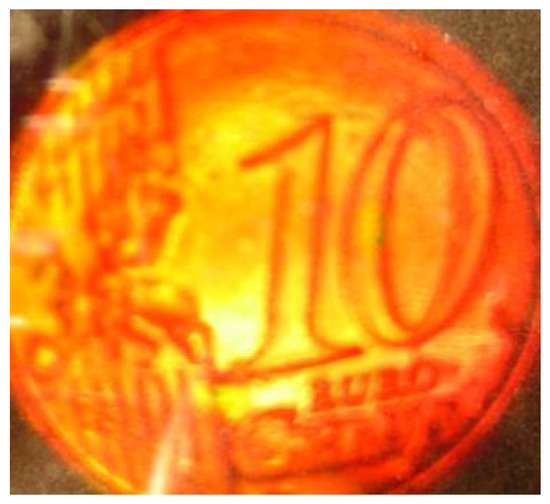
Figure 3.
Denisyuk reflection hologram recorded in DA-based photopolymer, illuminated in white light.
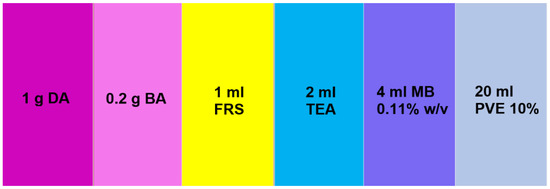
Figure 4.
Chemical composition of the pressure-sensitive photopolymer layers.
3.5. Holographic Pressure Sensors in DA-Based Photopolymer
Mihaylova et al. reported a new type of pressure sensor, based on a reflection hologram recorded in the DA-based photopolymers (Figure 3) [12]. The reflection holograms recorded in the DA-based photopolymers are of special interest for a variety of applications because of their ability to visualise the pressure distribution applied as colour maps without the need for scanning. Pressure-sensitive holograms have potential industrial and medical applications, where pressure visualisation devices are necessary, such as human gait measurement, balance and posture assessment, footwear research and design, implant prosthetics, implant occlusion, packaging and sealing, security devices, door seal testing, grip and ergonomics, impact studies, nip and pinch rollers, tire-tread footprint analysis, robotics, automation, and many others.
Figure 4 presents the chemical composition of the pressure-sensitive DA photopolymer layers.
The operating principle (Figure 5) of the holographic pressure sensor is that the colour of the reconstructed image from a reflection hologram, when illuminated by white light, depends on the pressure applied to the hologram.
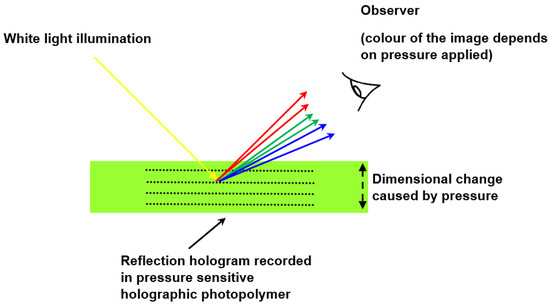
Figure 5.
Principle of operation of a holographic pressure sensor.
The holographic photopolymer is elastic and shrinks under pressure. The principle of the holographic pressure sensor is based on the change in the fringe spacing of the hologram under pressure. The change in the fringe spacing of the reflection hologram leads to a change in the colour of the reconstructed image, seen by the observer (Figure 5).
The Denisyuk setup for recording reflection holograms (Figure 6) is the simplest. The laser beam incident on the polymer layer serves as a reference beam while the laser light transmitted through the layer and reflected from the object serves as an object beam.
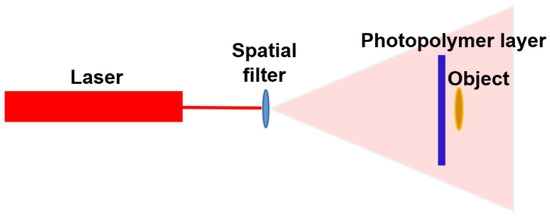
Figure 6.
Schematic of a Denisyuk set-up for recording reflection holograms.
The reflection holograms of a coin using the Denisyuk reflection geometry were recorded with a He–Ne laser at a wavelength of 633 nm.
The pressure applied to the holograms was measured using an INSTRON machine. The reflection holograms, recorded in the pressure-sensitive DA-based photopolymer composition, change colour under applied pressure. Figure 7 shows some of the results. It was observed that with the increase in the applied pressure, the colour of the reconstructed image changed from red to yellow—green—blue.
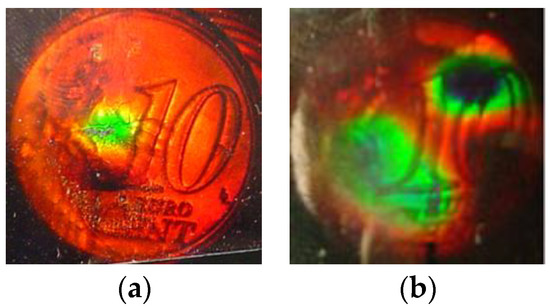
Figure 7.
Denisyuk reflection holograms recorded of a 10-cent coin subjected to pressure. The pressure applied was: (a) 50 N/cm2 for the green spot; (b) 70 N/cm2 for the dark blue spot.
4. Conclusions
Recently the demand for the mass production of holograms is increasing, especially for security applications. This is the main reason for the development of new photopolymer materials which are not harmful to the environment and have good holographic characteristics. Environmentally compatible materials for industrial use are required.
This paper reviewed recent developments in low-toxicity, water-soluble, holographic photopolymers, whose material characteristics compare favourably with the holographic characteristics of acrylamide-based photopolymers. It is clear that the development of environmentally friendly holographic photopolymers is an attractive field of research work in recent years.
The review describes three main groups of novel photopolymers, namely, Biophotopol, NIPA-based photopolymer, and Diacetone Acrylamide-based photopolymer, and their possible applications. The holographic storage capacity of Biophotopol is comparable to that of AA photopolymers. The most attractive application of the novel NIPA-based photopolymer is its memory of exposure to temperatures higher than 45 °C. Such a material can find application in temperature sensing.
Finally, the review describes an optimised DA-based photopolymer composition, which shows a remarkable improvement in holographic recording abilities in comparison to other recently developed, water-soluble, “green” photopolymer materials [19,20,21,22,23]. This material’s self-processing nature and low cost of production mean it is an excellent candidate for different industrial holographic applications. In addition, the DA-based holographic material is capable of recording reflection gratings with a high diffraction efficiency of 50%, the highest reported value for the diffraction efficiency of reflection holograms. Another attractive property of this new material is its high sensitivity to pressure, which can be controlled by changing its composition. Thus, the development of pressure sensors with different specifications is possible. Pressure-sensitive photopolymers open the possibilities for the production of new types of colour holograms.
This review shows that several different approaches are possible for the development of holographic photopolymers with low toxicity (Table 1) and very good optical quality and low scattering. There is room for future optimisation of all water-soluble holographic photopolymers by using different monomers, different chain transfer agents and different free radical scavenging agents in the PVA matrix.

Table 1.
Review summary of the basic chemical composition of the low-toxicity photopolymers and their key characteristics.
Funding
This research received no external funding.
Institutional Review Board Statement
Not applicable.
Informed Consent Statement
Not applicable.
Data Availability Statement
All data that support the findings of this study are included within the article.
Conflicts of Interest
The authors declare no conflict of interest.
References
- Calixto, S. Dry polymer for holographic recording. Appl. Opt. 1987, 26, 3904–3910. [Google Scholar] [CrossRef] [PubMed]
- Fimia, A.; Lopez, N.; Mateos, F.; Sastre, R.; A Pineda, J.; Amat-Guerri, F. Acrylamide photopolymers for use in real-time holography: Improving energetic sensitivity. Proc. SPIE 1992, 1732, 105–110. [Google Scholar] [CrossRef]
- Fimia, A.; Lopez, N.; Mateos, F.; Sastre, R.; Pineda, J.; Amat-Guerri, F. Elimination of Oxygen Inhibition in Photopolymer Systems Used as Holographic Recording Materials. J. Mod. Opt. 1993, 40, 699–706. [Google Scholar] [CrossRef]
- Martin, S.; Leclere, P.; Renotte, Y.; Toal, V.; Lion, Y. Characterisation of an acrylamide-based dry photopolymer holographic recording material. Opt. Eng. 1994, 33, 3942–3946. [Google Scholar]
- Blaya, S.; Mallavia, R.; Carretero, L.; Fimia, A.; Madrigal, R.F. Highly sensitive photopolymerisable dry film for use in real time holography. Appl. Phys. Lett. 1998, 73, 1628–1630. [Google Scholar] [CrossRef]
- Blaya, S.; Carretero, L.; Fimia, A.; Mallavia, R.; Madrigal, R.F.; Sastre, R.; Amat-Guerri, F. Optimal composition of an acrylamide and N,N′-methylenebisacrylamide holographic recording material. J. Mod. Opt. 1998, 45, 2573–2584. [Google Scholar] [CrossRef]
- Shi, D.; Yek, P.N.Y.; Ge, S.; Shi, Y.; Liew, R.K.; Peng, W.; Sonne, C.; Tabatabaei, M.; Aghbashlo, M.; Lam, S.S. Production of highly porous biochar via microwave physiochemical activation for dechlorination in water treatment. Chemosphere 2022, 309, 136624. [Google Scholar] [CrossRef]
- Hossain, M.K.; Rubel, M.; Akbar, A.; Ahmed, M.H.; Haque, N.; Rahman, F.; Hossain, J.; Hossain, K.M. A review on recent applications and future prospects of rare earth oxides in corrosion and thermal barrier coatings, catalysts, tribological, and environmental sectors. Ceram. Int. 2022, 48, 32588–32612. [Google Scholar] [CrossRef]
- Irfan, M.; Martin, S.; Naydenova, I. Temperature-Sensitive Holograms with Switchable Memory. Adv. Photon-Res. 2021, 2, 2100062. [Google Scholar] [CrossRef]
- Ramírez, M.G.; Sirvent, D.; Morales-Vidal, M.; Ortuño, M.; Martínez-Guardiola, F.J.; Francés, J.; Pascual, I. LED-Cured Reflection Gratings Stored in an Acrylate-Based Photopolymer. Polymers 2019, 11, 632. [Google Scholar] [CrossRef]
- Irfan, M.; Martin, S.; Obeidi, M.A.; Miller, S.; Kuster, F.; Brabazon, D.; Naydenova, I. A Magnetic Nanoparticle-Doped Photopolymer for Holographic Recording. Polymers 2022, 14, 1858. [Google Scholar] [CrossRef] [PubMed]
- Mihaylova, E.; Cody, D.; Naydenova, I.; Martin, S.; Toal, V. Research on Holographic Sensors and Novel Photopolymers at the Centre for Industrial and Engineering Optics. In Holography—Basic Principles And Contemporary Applications; Intech: Tokyo, Japan, 2013; pp. 89–102. [Google Scholar] [CrossRef][Green Version]
- Martin, S.; Feely, C.A.; Toal, V. Holographic recording characteristics of an acrylamide-based photopoly-mer. Appl. Opt. 1997, 36, 5757–5768. [Google Scholar] [CrossRef] [PubMed]
- Garcıa, C.; Fimia, A.; Pascual, I. Holographic behavior of a photopolymer at high thicknesses and high monomer concentrations: Mechanism of photopolymerization. Appl. Phys. A 2001, 72, 311–316. [Google Scholar] [CrossRef]
- Neipp, C.; Beléndez, A.; Gallego, S.; Ortuño, M.; Pascual, I.; Sheridan, J.T. Angular responses of the first and second diffracted orders in transmission diffraction grating recorded on photopolymer material. Opt. Express 2003, 11, 1835–1843. [Google Scholar] [CrossRef] [PubMed][Green Version]
- Meka, C.; Jallapuram, R.; Naydenova, I.; Martin, S.; Toal, V. Development of a panchromatic acryla-midebased photopolymer for multicolor reflection holography. Appl. Opt. 2010, 49, 1400–1405. [Google Scholar] [CrossRef] [PubMed]
- Yu, D.; Liu, H.; Mao, D.; Geng, Y.; Wang, W.; Sun, L.; Lv, J. Enhancement of spectrum strength in holographic sensing in nanozeolites dispersed acrylamide photopolymer. Opt. Express 2015, 23, 29113–29126. [Google Scholar] [CrossRef]
- Fernández, R.; Bleda, S.; Gallego, S.; Neipp, C.; Márquez, A.; Tomita, Y.; Pascual, I.; Beléndez, A. Holographic waveguides in photopolymers. Opt. Express 2019, 27, 827–840. [Google Scholar] [CrossRef]
- Cody, D.; Moothanchery, M.; Mihaylova, E.; Toal, V.; Mintova, S.; Naydenova, I. Compositional Changes for Reduc-tion of Polymerisation-Induced Shrinkage in Holographic Photopolymers. In Advances in Materials Science and Engineering; Hindawi Publishing Corporation: London, UK, 2016; Volume 2016, p. 8020754. [Google Scholar]
- Hashimoto, K.; Aldridge, W. Biochemical studies on acrylamide, a neurotoxic agent. Biochem. Pharmacol. 1970, 19, 2591–2604. [Google Scholar] [CrossRef]
- Mendel, F. Chemistry, biochemistry, and safety of acrylamide. A review. J. Agric. Food. Chem. 2003, 51, 4504–4526. [Google Scholar]
- Cody, D.; Casey, A.; Naydenova, I.; Mihaylova, E. A Comparative Cytotoxic Evaluation of Acrylamide and Diacetone Acrylamide to Investigate Their Suitability for Holographic Photopolymer Formulations. Int. J. Polym. Sci. 2013, 2013, 564319. [Google Scholar] [CrossRef]
- Ortuño, M.; Fernández, E.; Gallego, S.; Beléndez, A.; Pascual, I. New photopolymer holographic recording ma-terial with sustainable design. Opt. Express 2007, 15, 12425–12435. [Google Scholar] [CrossRef] [PubMed]
- Ortuño, M.; Gallego, S.; Márquez, A.; Neipp, C.; Pascual, I.; Beléndez, A. Biophotopol: A Sustainable Photo-polymer for Holographic Data Storage Applications. Materials 2012, 5, 772–783. [Google Scholar] [CrossRef] [PubMed]
- Navarro-Fuster, V.; Ortuño, M.; Gallego, S.; Márquez, A.; Beléndez, A.; Pascual, I. Biophotopol’s energetic sensitivity improved in 300 μm layers by tuning the recording wavelength. Opt. Mater. 2016, 52, 111–115. [Google Scholar] [CrossRef]
- Navarro-Fuster, V.; Ortuño, M.; Fernández, R.; Gallego, S.; Márquez, A.; Beléndez, A.; Pascual, I. Peristrophic multiplexed holograms recorded in a low toxicity photopolymer. Opt. Mater. Express 2016, 7, 133–147. [Google Scholar] [CrossRef]
- Mikulchyk, T.; Martin, S.; Naydenova, I. N-isopropylacrylamide-based photopolymer for hol-ographic recording of thermosensitive transmission and reflection gratings. Appl. Opt. 2017, 56, 6348–6356. [Google Scholar] [CrossRef]
- Cody, D.; Gul, S.-E.; Mikulchyk, T.; Irfan, M.; Kharchenko, A.; Goldyn, K.; Martin, S.; Mintova, S.; Cassidy, J.; Naydenova, I. Self-processing photopolymer materials for versatile design and fabrication of holographic sensors and interactive holograms. Appl. Opt. 2018, 57, E173–E183. [Google Scholar] [CrossRef]
- Cody, D.; Naydenova, I.; Mihaylova, E. New non-toxic holographic photopolymer material. J. Opt. A Pure Appl. Opt. 2012, 14, 015601. [Google Scholar] [CrossRef]
- Siemiatycki, J.; Richardson, L.; Straif, K.; Latreille, B.; Lakhani, R.; Campbell, S.; Rousseau, M.; Boffetta, P. Listing occupational carcinogens Environ. Health Perspect. 2004, 112, 1447–1459. [Google Scholar] [CrossRef]
- Acrylamide, D.; Sigma-Aldrich. Available online: http://www.sigmaaldrich.com/catalog/DisplayMSDSContent.do (accessed on 30 June 2011).
- Coleman, L.E.; Bork, J.F.; Wyman, D.P.; Hoke, D.I. Synthesis and polymerization of N [2-(2-methyl-4-oxopen-tyl)]-acrylamide–A new reactive vinyl monomer. J. Polym. Sci. 1965, 3, 1601–1608. [Google Scholar]
- Gallego, S.; Ortuno, M.; Neipp, C.; Garcia, C.; Belendez, A.; Pascual, I. Overmodulation effects in volume holograms recorded on photopolymers. Opt. Comm. 2003, 215, 263–269. [Google Scholar] [CrossRef]
- Blaya, S.; Carretero, L.; Mallavia, R.; Fimia, A.; Madrigal, R.F.; Ulibarrena, M.; Levy, D. Optimization of an acrylamide-based dry film used for holographic recording. Opt. Soc. Amer. 1998, 37, 7604–7610. [Google Scholar] [CrossRef] [PubMed]
- Huawen, Y.; Mingju, H.; Zhongyu, C.; Lisong, H.; Fuxi, G. Optimization of two-monomer-based photopolymer used for holographic recording. Mater. Lett. 2001, 56, 3–8. [Google Scholar]
- Hai, L.; Ruo-Ping, L.; Cai-Xia, S.; Yong, X.; Dao-Guang, T.; Ming-ju, H. Holographic property of photopolymers with different amine photoinitiators. Chin. Phys. B 2010, 19, 242121–242127. [Google Scholar] [CrossRef]
- Cody, D.; Gribbin, S.; Mihaylova, E.; Naydenova, I. Low-Toxicity Photopolymer for Reflection Holography. ACS Appl. Mater. Interfaces 2016, 8, 18481–18487. [Google Scholar] [CrossRef] [PubMed]
Publisher’s Note: MDPI stays neutral with regard to jurisdictional claims in published maps and institutional affiliations. |
© 2022 by the author. Licensee MDPI, Basel, Switzerland. This article is an open access article distributed under the terms and conditions of the Creative Commons Attribution (CC BY) license (https://creativecommons.org/licenses/by/4.0/).